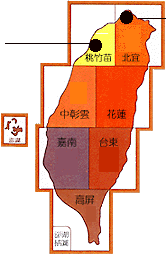中華大學資管系 課名:多媒體系統 By 張燕光老師 |
from each other. |
輔仁大學英語系 課名:電腦輔助教學 By 葉修文老師 |
|
Objectives |
Schedule |
Requirements |
Students/Projects |
| 溝通方式
Communications |
|
|
計畫說明
Project Guidelines |
中華大學資管系 課名:多媒體系統 By 張燕光老師 |
from each other. |
輔仁大學英語系 課名:電腦輔助教學 By 葉修文老師 |
| 近幾年,多媒體CAI深獲國內資訊界與英語教學界的注意。隨著多媒體電腦的蓬勃發展與光碟機的普及,加上我國中、小學課程的變革﹝如:中、小學資訊教育與國小英語教學的正式納入課程﹞,國內電腦輔助語言教學的發展可謂潛力無窮。
CAI軟體是團隊合作的產物。以英語教學為例,多媒體科技誠然為英語教學開創新契機,然而有效的教學效果需有優良的教學軟體配合,且軟體的設計需整合多媒體科技、英語教學、與教學設計等多方面的人才方能達成。本計畫的目的即在提供英語系與資管系學生一個跨校、跨系、跨領域的合作機會,共同設計多媒體英語教學軟體。學生可藉此機會了解來自不同領域的看法,彼此切磋學習,期能提昇軟體設計的品質。 |
|
|
Class |
|
|
|
| 1 | 2/25 | 簡介 | ||
| 2 | 3/1 | 簡介;
分組; 開始聯絡 |
3/1, 3/4 | 分組;
開始聯絡 |
| 3 | 3/8 | 確定題目 | 3/8, 3/11 | |
| 4 | 3/15 | Preliminary Design | 3/15, 3/18 | |
| 5 | 3/22 | Design | 3/22, 3/25 | |
| 6 | 3/29 | 確定所有資料已給對方 | 3/29, 4/1 | Programming |
| 7 | 4/5 | 春假 | 4/5, 4/8 | 春假 |
| 8 | 4/12 | 4/12, 4/15 | ||
| 9 | 4/19 | 4/19, 4/22 | ||
| 10 | 4/26 | 軟體展示 | 4/26, 4/29 | |
| 11 | 5/3 | 軟體展示 | 5/3, 5/6 |
| Fu-Jen Side | Chung-Hua Side |
| 1.註冊並學習中華資管系BBS站聊天功能(Talk)
2.註冊並學習本網站Thread-Post功能 3.將Project題目貼於Thread-Post並接受詢問 4.將PreliminaryDesign貼於Thread-Post並接受詢問 5.將Design貼於Thread-Post並接受詢問 6.將課程資料寄給對方:包括所有文字資料、圖片資料、影音資料 7.展示軟體 |
1.協助對方註冊並學習中華資管系BBS站聊天功能(Talk)
2.註冊並學習本網站Thread-Post功能 3.至Thread-Post閱讀並與對方討論Project Topic, Preliminary Design, Design 4.確定收到所有資料:包括文字資料、圖片資料、影音資料 5.設計軟體 |
|
|
|
|
|
|
![]() Students/Projects:
Students/Projects:
Go to Message
Board(請至留言版討論)
1. What is your topic?
2. What are the instructional needs? Explain them in a paragraph.
3. What are the overall project goals? Explain them in a paragraph.
4. What are the subject matter of your CAI program?
Analyze them in a paragraph.
5. What are your possible resources? (e.g., video, audio, text, animation,
pictures, etc.)
6. What type of CAI do you employ? Explain them in a paragraph.
a. Drill and practice
Provides the opportunity for repetitive work on skills or concepts that
have been
previously introduced.
b. Tutorials
Provides information, generally new information, to the learner in much
the same
manner that a human teacher or tutor might.
c. Simulations
Imitations of real of in some cases imaginary systems or phenomena. In
most
cases, they are simplified representations of the real things.
d. Instructional games
Usually employed to increase learners' motivation.
e. Problem-solving software
Designed to give students experience with a variety of problem and solution
approaches.
1. Analyze and outline all the content and skills you want to teach.
2. Instructional strategies.
3. Design feedbacks and responses. (See Appendix A to view some factors.)
4. Interface design.
Project III. Flowchart and Storyboards
 |
1. 輔大英文系Threads留言版。
中華資管系中華資管夜未眠 。 2. 中華資管系BBS站聊天功能(Talk) (telnet bbs.mi.chu.edu.tw) 3. E-mail電子郵件。 4. 電話。 5. 郵寄。 |
(From Chapter 7 of: Alessi,
S.M. & Trollip, S.R. (1991). Computer-Based Instruction: Methods
and Development, 2nd edition. Englewood Cliffs, New Jersey: Prentice-Hall.)
| Activities | Explanations | Designer | |
| 1 | Determine needs and goals | * Determine what the student should know or be able to do after completing the lesson. | Fu-Jen |
| 2 | Collect resources | * Relevant to subject matter, instructional development, and delivery
system.
* In this course they refer to things such as textbooks, reference books, original source materials, films, audio tapes, etc. |
Fu-Jen |
| 3 | Learn the content | * The designer must be very familiar with the content.
* Ex. interviewing the expert, reading texts and other instructional materials. etc. |
Fu-Jen |
| 4 | Generate ideas | * Do brainstorming to generate creative ideas. | Fu-Jen |
| 5 | Design instruction | * Performing concept and task analyses on the content.
* Preliminary choices about instructional methodologies and factors. |
Fu-Jen |
| 6 | Flowchart the lesson | * Depicts the sequence and decisions of a lesson.
* The visual representation of decisions and events is the best way to depict the interactions between computer & learners. |
Fu-Jen |
| 7 | Storyboard displays on paper | * Depicts the content and presentations.
* The process of preparing textual and pictorial displays so they will fit within the display limitations of your computer. * Include information presentations, questions, feedback, directions, prompts, pictures, and animations. |
Fu-Jen & CHU |
| 8 | Program the lesson | * Translate what you have on paper into a series
of instructions
understandable to the computer. |
CHU |
| 9 | Produce supporting materials | Fu-Jen & CHU | |
| 10 | Evaluate and revise | Fu-Jen & CHU |
![]() Features
of the procedure:
Features
of the procedure:
| 中華大學資管系
課名:多媒體系統 By 張燕光老師 |
 |
輔仁大學英語系
課名:電腦輔助教學 By 葉修文老師 |